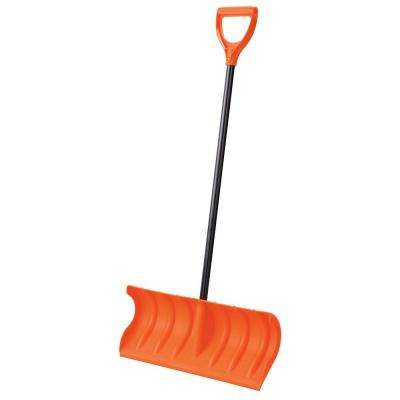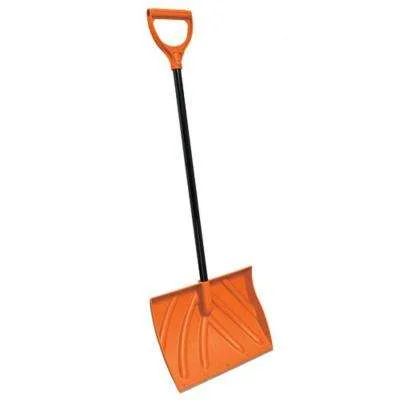
Picking the Perfect Snow Shovel
There are so many choices when picking a shovel in Saratoga Springs. How can you tell what works and what is a great marketing ploy? Check out this article where we discuss different shovels.
Straight handle, curved handle, flat blade, scooped blade. There are so many options when selecting a snow shovel it can be overwhelming. We have done some research, and testing of our own, to give you the scoop on the best snow removal tools.
Straight vs. Curved Handle
Curved handle snow shovels have been out for a few years. But are they worth the money? The short answer is ‘maybe’. The idea behind a short handle is to reduce bending forward when you scoop the snow. In some studies, a bent handle can reduce the load on the lower back by up to 16%. That reduction in load could add up depending on how much snow you are moving and how heavy. One thing to note is that only considers lifting the snow, not throwing it. The trick to shoveling is to use your legs to get most of your power. As people fatigue, they use their lower back instead of their legs to create force and leverage. A concept that can lead to a great deal of pain in following days.
Now that you’ve lifted the snow off the ground, what do you do with it? The ergonomics of a curved handle cause the majority of the weight to be on the front hand due to an inefficient lever. When you try and clear the snow, that font hand, wrist, elbow and shoulder must work harder than with a straight handle.
Based on our research and own experience, we feel it is best to use a traditional straight handle and reduce the risk of injury to multiple body parts. Plus, you most likely grew up shoveling with a straight handle so you are already accustomed to that design.
In this category, the straight shovel is our favorite!
Snow Shovel vs. Snow Push Shovel
I have to be honest, until I really started to look into this I had no idea how many snow shovels there really were. For the sake of keeping things relatively simple, I have narrowed it down to the two most popular varieties.
To determine which one is best you need to understand what each is intended to be used for. Let’s start with the snow shovel. This has more of a flat and square blade and is best for lifting the snow. Let’s say you are clearing a sidewalk and need to pile the snow; a snow shovel may be your best bet. The push shovel is best for, well, pushing snow. In the instance of light, powdery snow a push shovel may be best to clear large areas where you don’t have to lift the snow. These blades are usually wider (18-24”) and have a rounded feature. For most people the most versatile shovel will be the traditional snow shovel as this will allow you to both push and lift the snow.
We only covered two of the many types of snow shovels but we encourage you to check out other kinds and if you have questions, let us know.
No matter what shovel you choose, please make sure you dress warm, stretch before you shovel and stay hydrated. The majority of injuries we see after a snow storm are related to shoveling snow. For more information on how to keep yourself healthy when the snow piles up, check out our post “A Chiropractor’s Guide to Surviving a Snow Storm”.
Happy Shoveling!
A Chiropractor's Guide to Surviving a Snowstorm
Saratoga Springs is known as being a Summer destination, but the Winters an be just as fun. Whether you hate the snow or love, this article is all about staying healthy when the snow falls.
Living in Saratoga Springs just about guarantees at least one snowstorm each winter. When this happens, you may find yourself shoveling snow, running inside or packing your gear to head to the mountain. Whether you’re dreading the snow or dreaming of it, check out this chiropractic guide to staying healthy for any snowstorm.
Shoveling
Shoveling snow is hard to avoid during a big storm. Whether you’re just cleaning off your sidewalk or clearing your driveway, there are a few things to keep in mind.
The green outlines posterior and anterior oblique slings. The muscle system that is dominant when doing rotational activity. These can be easily overworked on one side when shoveling.
Timing
Most people end up shoveling in the morning. If that is the case, don’t roll out of bed, throw on your clothes and head outside. Shoveling is strenuous work and a proper warm up is required. Even if that means waiting for 10 minutes and just doing some basic stretches to get your body loose.
We also recommend that you don’t eat right before you shovel. You will be moving close to 100 pounds of snow every minute. That requires a great deal of effort from your body. As with any exercise, your heart rate raises to deliver oxygen to your tiring muscles. Eating a big meal also requires an increase in heart rate and pulls blood away from the heart to aid in digestion. There are many cases of people suffering heart attacks from eating right before shoveling. Just because you’re using your snow blower doesn’t mean you’re out of the clear either. Physical stress is physical stress, your heart doesn’t know the difference.
Mechanics
The way you shovel can increase your risk of injury, especially if the snow is heavy. Make sure to bend your knees, keep the shovel close to you and move your feet. It is also beneficial to switch sides that you hold the shovel on. I know this may feel strange but it will help you build balance and strength and take let one group of muscles rest while another is working.
If you are looking for that perfect shovel and are confused about the different options, check out our post “Picking the Perfect Snow Shovel”.
Winter Sports
Dress warm
Whether you’ll be building a snowman or hitting the slopes, it is important to have the proper clothing to keep you warm. Make sure you dress in layers. Dressing in layers traps a thin amount of air that can be heated by your body to further keep you warm. Multiple layers also helps keep you dry by adding additional protection against melting snow.
keep your neck covered
When the temperature drops, the natural reaction is to tilt your head down and put your mouth and nose in your jacket. This will warm the air entering your mouth and keep your core warm. The problem is this can lead to a great deal of neck pain, shoulder pain, and headaches. So instead, make sure you wear something to keep your neck and face warm, and practice good posture.
Stay hydrated
The last, but certainly not least piece of advice, is to stay hydrated. Our bodies use water to regulate temperature. In the summer months, it is easier to tell when we are getting dehydrated but when you are cold, symptoms can be less obvious. Most people choose to get a warm beverage like coffee during colder months. It is important to note that coffee is a diuretic and that water needs to be replaced. If you drink coffee, make sure to consume double the amount of water as coffee that you drank.
Saratoga Springs transforms into a magical place after a snowstorm. At Turning Point Chiropractic, we hear the good and not-so-good impacts of snow. If you find yourself in pain, don’t make the mistake of waiting to get treated. Taking care of yourself is the only way to ensure you will enjoy all that winter has to offer. If you have any questions, give us a call. We are here to help!







